Introduction Tsavo ecosystem is fast drying up greatly reducing the available watering points thus forcing most wildlife to travel long distances to the few remaining permanent or artificially provided watering areas such as the windmills and water holes outside lodges
Introduction
Tsavo ecosystem is fast drying up greatly reducing the available watering points thus forcing most wildlife to travel long distances to the few remaining permanent or artificially provided watering areas such as the windmills and water holes outside lodges. Cases handled in the month included treatment of an injured elephant bull in the Kiboko area of Chyulu, desnaring of elephants in Mkuki ranch and Tsavo east national park, Rhino ear notching within Ngulia Sanctuary and finally collaring of lions in Kuku group ranch in Chyulu.
CASE#1 TREATMENT OF A WOUNDED ELEPHANT BULL
Date: 1st June 2014
Species: Elephant
Sex: Male
Age: Adult
Location: Kiboko area, Chyulu National Park
History:
The elephant was spotted near Kiboko area along the Nairobi - Mombasa highway in a group of 4 other bulls foraging in a nearby bush. The oldest bull had a big wound on the right front leg. These bulls were deep inside the community area and it’s thought a poaching attempt was the cause of the injury.
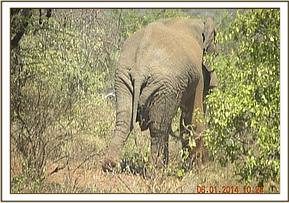

Immobilization, examination and treatment
Immobilization was done using 18 mgs of Etorphine propelled in a Dan Inject Dart System and went down in 5 minutes. The elephant was treated for a small injury on the left front leg before being rolled over by use of vehicle, to allow for treatment of the bigger wound on the caudal side of the right front limb.
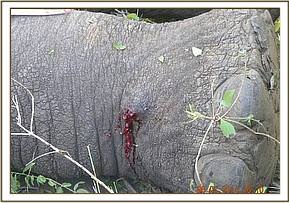

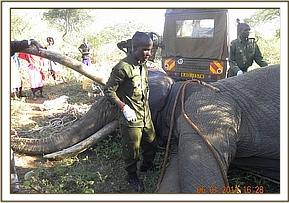

The large wound was thoroughly washed with water mixed with Hydrogen Peroxide in a ratio of 1:1. Necrotic tissues and pus debris were removed leaving a raw wound. Tincture of Iodine was applied evenly and Oxytetracycline spray administered. A layer of green clay was used to cover the wounded area to aid in healing. Long acting antibiotics (Betamox LA) and dexamethasone were injected parenterally.

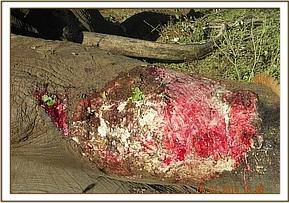


Prognosis:
The elephant was given a good prognosis and revived to join the rest of the herd.


CASE#2 TRANSLOCATION OF A HANDREARED ZEBRA
Date: 9th June 2014
Species: Zebra
Sex: Male
Age: Sub adult
Location: Voi Stockade to Sagala Lodge
History:
The zebra was rescued while still a foal after it was found by herders near a manyatta in Ndii area of Tsavo West national park. He was raised until near adult hood after which he started becoming aggressive and sometimes attacking guests, hence the need to re-integrate him back to the wild.
Immobilization, examination and treatment
Physical capture was difficult and he was immobilized through darting using 4 mgs of Etorphine and 40 mgs Xylazine. He was loaded into truck under anaesthesia, transported to the Sagalla ranch and offloaded before being revived. Feeds and water were supplied and the keeper instructed to re-unite him with other resident zebras after a week.
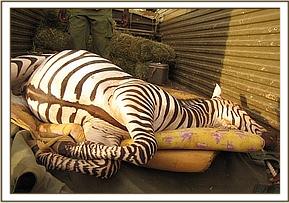

CASE#3 TREATMENT OF A SNARED ELEPHANT
Date: 14th June 2014
Species: Elephant
Sex: Female
Age: Adult
Location: Mkuki Ranch
History:
A case of injured young elephant cow was seen by KWS rangers while patrolling the Mkuki ranch; one of the many ranches hosting wildlife within the Tsavo ecosystem. The team responded fast and easily found the injured elephant not far from a water hole.
Immobilization, examination and treatment
The elephant was darted using 16 mgs of Etorphine using a Dan Inject dart system. The front right leg had a tight and deep cutting wire snare that caused severe tissue damage and bleeding. Infection had already set in but luckily the distal part of the foot had good blood supply. The wire snare was cut loose and the wounded area washed using Hydrogen Peroxide mixed with water. Dead tissue debris was then removed and tincture of Iodine applied. Green clay was used to cover the wound to aid in healing and keep dirt from entering the wound.
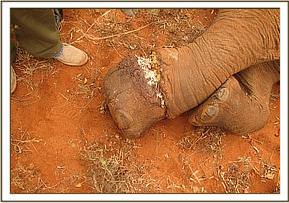
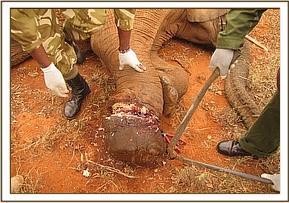
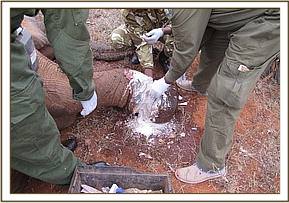

Prognosis:
Long acting antibiotics and anti-inflammatory drugs were injected intramuscularly and the elephant handed a guarded prognosis and revived. Close monitoring was advised.


CASE#4 TREATMENT OF A SNARED ELEPHANT
Date: 16th June 2014
Species: Elephant
Sex: Female
Age: Adult
Location: Tsavo East National Park
History:
The lone elephant cow was seen by the David Sheldrick Wildlife Trust patrol aeroplane along Galana River trying to spray water onto its wounded neck. She was easily spotted again the next morning foraging inside the park by the DSWT aeroplane.
Immobilization, examination and treatment
The elephant was darted using 16mgs of Etorphine propelled in a Dan Inject dart system from a vehicle and she was immobilized in 6 minutes. A tight deeply cutting wire snare which went round the neck could have killed the elephant were it not for the ear flap that protected part of the neck. Luckily major blood vessels were not affected.


Pus debris and necrotic tissues were cut off, wounds washed with Hydrogen Peroxide mixed with water, doused with tincture of Iodine and sprayed with Oxytetracycline spray. Wetted green clay was used to cover the injury. Long acting antibiotics and Dexamethasone Hcl were administered parenterally.


Prognosis:
Prognosis given was guarded.
CASE#5 RHINO EAR NOTCING EXERCISE
Date: 18th – 25th June 2014
Species: Rhino
Sex: Male and Female
Age: All ages
Location: Ngulia
History:
Rhino ear notching is done every 2 years to enable proper identification of individuals that aid in census and monitoring. The last ear notching was undertaken in March 2012. A total of 12 Rhinos of different ages and sexes were ear notched in an operation that took 8 days.
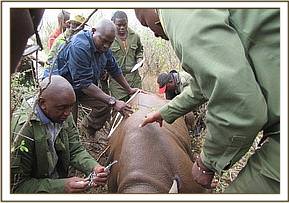

Immobilization and Ear Notching:
Helicopter darting was used to immobilize the rhinos as there was heavy bush undergrowth. Adults were immobilized using 4.5 mgs Etorphine and 80 mgs Azaperone. Three year olds were immobilised with 2 mgs Etorphine and 40 mgs Azaperone. Tissue, parasitic and blood samples were taken and preserved. Respiratory complications were noted and dealt with via administration of Burtophanol and Narlophine plus Doxopram; a respiratory stimulator. The exercise will again be undertaken in about two years when the current calves will have attained a good age.


CASE#6 LION COLLARING EXERCISE
Date: 28th – 30th June
Species: Lion
Sex: Female
Age: Adult
Location: Kuku Ranch, Chyulu
History:
Kuku ranch is a community conservation area bordering Tsavo West National Park and Chyulu National Park. Human predator conflict is high in the mainly pastoralist community that keep livestock as their economic activity. Understanding the dynamics of predator activity especially lions is crucial in solving the rampant human-wildlife conflict in this area hence the need to deploy satellite linked collars that will avail crucial information on lion movements. Collars were to be deployed on 3 lions but only one was successful.
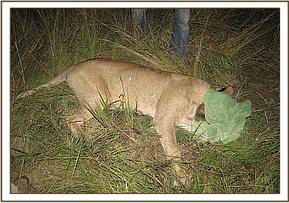
Immobilization and Collaring
The lioness was immobilized using 300 mgs of Ketamine and 3.5 mgs of Meditomidine hcl at night by aid of a night vision equipment after herbivores in distress sounds were played to attract them. The collars were fitted with enough space to allow the lioness to feed and move with ease. The lioness was revived one hour later and monitored closely she moved away on her own. The remaining collars will be deployed at a later date.

Conclusion and acknowledgement
Cases of elephant injuries through snares dominated the cases handled in the month of June. Most of the cases reported were cows. The unit will continue responding to cases as they are reported in the region.
The unit would like to appreciate the support of its sponsors ViER PFOTEN through the David Sheldrick Wildlife Trust (DSWT) for their continued support that enabled us save suffering wildlife at their time of need. We also thank Kenya Wildlife Service through the Assistant director Tsavo conservation area and the head, veterinary and capture services department for their contribution.
Reported by:-
Dr Jeremiah Poghon